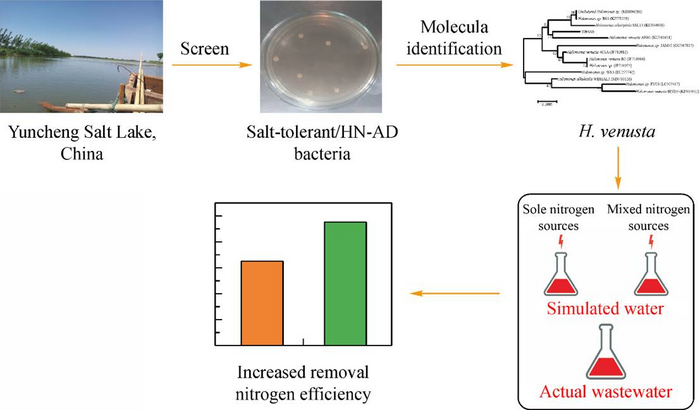Numerous industries produce hypersaline wastewater that contains nitrogen, which poses a serious threat to the aquatic environment. Ammonia nitrogen buildup frequently promotes excessive algal growth, which lowers the amount of dissolved oxygen in the water and eliminates higher species.

Image Credit: Quanli Man, Peilian Zhang, Weiqi Huang, Qing Zhu, Xiaoling He, Dongsheng Wei.
Meanwhile, the presence of nitrite and nitrosamine in water poses a major hazard to the well-being of individuals, animals, and microorganisms. The removal of nitrogen from high-salinity wastewater is therefore urgent.
Bacteria that remove nitrogen from wastewaters through heterotrophic nitrification and aerobic denitrification (HN-AD) provide excellent means to do so and reduce the need for sewage treatment and operating expenses.
However, some HN-AD bacteria are either not suitable for hypersaline settings or previously described salt-tolerant bacteria only exhibit significant nitrification but low denitrification activity under high-salinity conditions and are not suitable for high-nitrogen concentrations.
What should be done with wastewater that has a high salt and nitrogen concentration before releasing it into the environment?
Prof. He from Tiangong University, Prof. Wei from Nankai University, Dr. Man from Tiangong University, and their teams collaborated to investigate the nitrogen removal capabilities of H. venusta TJPU05 isolated from Salt Lake sediment in simulated water with sole or mixed nitrogen sources as well as in actual wastewater with high concentrations of salt and nitrogen.
Their research not only showed that the H. venusta TJPU05 treatment procedure has outstanding potential for handling high-salinity nitrogenous wastewater, it also offers a viable supply of microorganisms for denitrification of high-nitrogen, hypersaline wastewater.
A heterotrophic nitrification-aerobic denitrification bacterium called Halomonas venusta TJPU05 that is suitable for removing nitrogen from highly salinized wastewater is described in the study published in Frontiers of Environmental Science & Engineering.
In this investigation, the research team discovered a novel salt-tolerant HN-AD bacterium, Halomonas venusta TJPU05, in Salt Lake sediment. This bacterium demonstrated excellent HN-AD abilities in simulated water (SW) and actual wastewater (AW), both of which had high concentrations of salt and nitrogen.
The team concluded that the maximum amount of time for the removal of 86.12% of NH4+–N, 95.68% of NO3––N, 100% of NO2––N, and 84.57% of total nitrogen (TN) from SW using only nitrogen sources was 24 hours.
Additionally, when the salinity was above 8%, H. venusta TJPU05 was able to maximally remove 84.06% of NH4+–N, 92.33% of NO3––N, 92.9% of NO2––N, and 77.73% of TN from SW with a mixed nitrogen source.
Without any optimization, the removal efficiencies for NH4+–N, NO3––N, and TN were respectively 50.96%, 47.28%, and 43.19% when H. venusta TJPU05 was used to treat AW with high salt and high ammonia nitrogen.
Moreover, at salinities of 5% and 8%, respectively, the enzymes ammonia oxygenase, hydroxylamine oxidase, nitrate reductase, and nitrite reductase showed their maximum activity levels.
This study identified the H. venusta TJPU05, a novel salt-tolerant heterotrophic nitrification, and aerobic denitrification bacterium, and showed its huge potential for treating high-salinity nitrogenous wastewater. In addition, this discovery offers a resource for microorganisms that has great potential for removing nitrogen from hypersaline wastewater.
Journal Reference:
Man, Q., et al. (2022) A heterotrophic nitrification-aerobic denitrification bacterium Halomonas venusta TJPU05 suitable for nitrogen removal from high-salinity wastewater. Frontiers of Environmental Science & Engineering. doi:10.1007/s11783-021-1503-6.